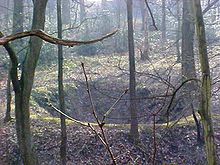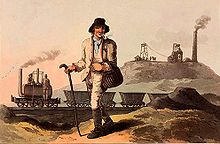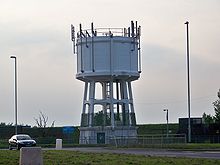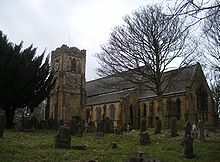- Middleton, Leeds
-
Coordinates: 53°44′34″N 1°33′09″W / 53.7428°N 1.5526°W
Middleton 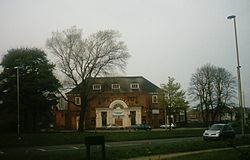
The Middleton Arms
 Middleton shown within West Yorkshire
Middleton shown within West YorkshireOS grid reference SE2927 Metropolitan borough City of Leeds Metropolitan county West Yorkshire Region Yorkshire and the Humber Country England Sovereign state United Kingdom Post town LEEDS Postcode district LS10 Dialling code 0113 Police West Yorkshire Fire West Yorkshire Ambulance Yorkshire EU Parliament Yorkshire and the Humber UK Parliament Morley and Rothwell List of places: UK • England • Yorkshire Middleton is a suburb of Leeds 4 miles (6 km) south of Leeds city centre, West Yorkshire, England. It originated as an agricultural and pit village in south Leeds and is mentioned as Mildentone and Mildetone village in the 1086 Domesday Book.
In 1870-72, John Marius Wilson's "Imperial Gazetteer of England and Wales" described Middleton as:
..a village, a township, and a chapelry in Rothwell parish West Riding of Yorkshire. The village stands on an eminence, 4 miles S of Leeds railway station; and commands extensive views. The township contains also the hamlet of Belle-Isle. There are several extensive collieries; and a tram road goes to the Brandling wharf at Leeds.-The chapelry is more extensive than the town...Coal mining in Middleton ceased in 1968 when Broom Pit, the last of the Middleton Collieries closed. When Leeds Corporation embarked on a programme of extensive slum clearance in Hunslet the early 1920s, Middleton became the location for one of the vast council estates built on the city outskirts. Today Middleton is a residential suburb of South Leeds. Most residents of Middleton are employed elsewhere in the city. The area has one of the highest unemployment rates in the country.
Contents
History
The name Middleton is derived from the OE middel-tun, in this case the middle settlement or farm on the road from Morley to Rothwell.
Flint and bronze weapons have been discovered in the neighbourhood of Middleton showing evidence of habitation during the Palaeolithic and Bronze Ages ages. Roman discoveries were made in 1607 and 1823.[1] Middleton was mentioned in the Domesday Book as having 3 carucates of land. Much of the area was woodland. The land was given to Ilbert de Lacy who had a castle at Pontefract.[1] Middleton Park is a remnant of the manorial estate which existed after the Norman Conquest. In the twelfth century the boundary between Middleton and Beeston became the focus of a protracted legal dispute between William Grammary and Adam de Beeston. The dispute was over where the boundary lay through the dense woodland which then covered the area. The dispute was settled in 1209 by "single combat" and the construction of a boundary bank and ditch, a stretch of which can still be seen in Middleton Woods.[1]
The Creppings were Lords of the Manor followed by the Leigh or Legh family. John of Gaunt, 1st Duke of Lancaster, held the Manor from 1363–1370 and Simon Simeon, whose will mentioned coal mines, from 1401 - 1406.[1] The Leighs held the manor for much of the time between 1300 until 1697 when Anne Leigh married Ralph Brandling of Felling, Co Durham.[1] Middleton Hall on Town Street, built in the 18th century was the Brandling's Middleton home but they chose to live mainly in their Durham home. Charles John Brandling of Gosforth House was Member of Parliament for Newcastle 1798-1812 and for Northumberland 1820-1826. He married Henrietta Armitage, heiress of Middleton. John Blenkinsop, the colliery manager was the Middleton Hall's occupant in 1809. Middleton Hall was destroyed in a fire in 1962.[2]
In 1760 the Brandlings built a new residence, Middleton Lodge, designed by James Paine in what is now the park possibly where the original manor house stood.[3] Members of the Brandling family lived there until 1860 including R.H. Brandling who donated the site on which the church is built. The estate was sold in 1862 to the Middleton Estate & Colliery Company.[4] In 1871 William Henry Maude, partner in Middleton Estate & Colliery Co. lived there with his sister. He died in a carriage accident in the park in 1911. His sister kept tenancy of the Lodge after the land had been acquired by the council in 1920 until her death in 1933. After her death the Lodge became headquarters of Middleton Golf Club until 1986 when it was demolished.
Industrial history
Middleton was built around coal.[5] There is evidence of coal mining dating back to the Middle Ages in the shaft mounds, waggonways and similar archaeological features resulting from early mining activity in Middleton Woods.[6] The earliest pits were bell pits in the 17th century or earlier.[7] Adits or day holes were dug horizontally into the hill sides.[8] In 1669 Frances Conyers of New Hall had "cole pits" in Middleton.[9] Gin pits with brick lined shafts and wooden headgear to haul up the buckets of coal and horses to turn the windlass were the next development. This type of mine was in operation when Anne Leigh married Ralph Brandling. The pits were small and many worked for a short time.[10] The Brandlings owned six collieries in Durham. The 1,200 acre Middleton Hall estate supplied coal to Leeds but was disadvantaged in the trade by poor roads.[11] Deep mining arrived with the advent of steam engines which pumped water out of the mines and kept the workings dry and made it possible to raise coal quickly from greater depths. In 1780 a Newcomen engine was installed at Middleton.[11] The market for coal grew as Leeds and its industries expanded.[12] The mine employed 90 hewers and 60 putters by 1808.[11]
The Middleton Railway founded in 1758 is the oldest continuously working railway in Britain, and was established by an Act of Parliament. This was England's first railway Act. The railway, owned by Charles Brandling, (1733-1802), was a horse drawn wooden waggonway linking the collieries at Middleton with Cassons Close near Leeds Bridge. Its purpose was to transport coal from the mines to the centre of Leeds.[13] In 1810 John Blenkinsop, Brandling's manager at Middleton Colliery was looking for cheaper ways to move coal to Leeds.[14] Blenkinson designed the world's first rack railway[15] and Matthew Murray built "Salamanca", the first Middleton Railway locomotive at his Round Foundry in Holbeck. The first run was reported in The Leeds Mercury on 27 June 1812. It was "witnessed by thousands of spectators and crowned a complete success....".[16] Three more locomotives were built. The Middleton Railway locomotives had a toothed cog wheel which meshed into a rack on the side of the rail, as it was felt this would provide the engines with a better grip when hauling coal wagons.[17][18]
Before 1840 women and children were employed in the mines and there were frequent accidents. The worst disaster occurred in 1825 at the Gosforth Pit where an explosion of firedamp caused 24 deaths, the oldest a collier aged 48 and the youngest a child of five.[19]
Broom Pit was the deepest at 810 feet (250 m) and longest lasting of the Middleton collieries. Operations at the pit ended in 1959 as the productivity of the colliery declined. The colliery had been the largest employer in the area, and its closure in 1968 began a very long process of decline for Middleton.[20]
20th century
Middleton was incorporated into the county borough of Leeds on 1 April 1920 and soon afterwards the Middleton housing estate, "a vast low-density Corporation built cottage estate with circuses and avenues"[21] was built using bricks from the Fireclay Works at Broom Pit.[22] The estate was built on land once used for agriculture including West Farm and parts of Sissons Farm. By 1934 2,377 houses had been built and the estate considered to be a "garden suburb", however it was considered remote and lacking in facilities by the residents. In 1919 the once private grounds of Middleton Lodge were leased by the council for use as a public park. The Westwoods and Manor Farm estates were developed in the 1960s. A large private estate was built at Sharp Lane after 1972 and 1,300 houses are being built at Leeds New Forest Village.[23]
Governance
Middleton was a township and chapelry in the ancient parish of Rothwell in the Agbrigg-division of the wapentake of Agbrigg and Morley in the West Riding of Yorkshire.[24] It became an ecclesiastical parish after 1849. Between 1866 and 1920 it was a civil parish [25] and in 1920 was incorporated into the City of Leeds.[26]
Boundary changes put Middleton in the Leeds Central parliamentary constituency at the 2010 General Election. Previously the area was in the Morley and Rothwell constituency. Middleton is in the Middleton Park electoral ward and is represented on Leeds City Council by three Labour councillors (as at May 2010).[27]
Geography
Middleton, south of Leeds, occupies part of a plateau which falls away sharply to the west (towards Dewsbury Road) and to the north of Town Street. The underlying rocks are the coal measures and a bed of fireclay which was worked by the Middleton Estate and Colliery Company to make bricks and other products. Several of the higher coal seams outcrop in Middleton Park, between the coal seams are sandstones and shales.[28] The old village grew up along Town Street which runs west-east along the ridge. Middleton housing estate occupies flattish land on the plateau. The high point of the Middleton is by the water tower about 500 feet (150 m) above mean sea level. The township covered about 1700 acres,[24] of which 450 are woodland known as Middleton Woods, the largest area of ancient woodland remaining in Leeds.[29] The suburb is flanked by the M62 to the south, the M1 to the east and the M621 to the north.
Neighbouring towns, villages and places. 
Churwell Hunslet, Leeds Belle Isle, Leeds 
Morley, West Yorkshire 
Rothwell  Middleton
Middleton 

Batley, Dewsbury East Ardsley Wakefield Economy
Middleton is a residential area, there are areas of multiple deprivation, but a Middleton Regeneration Board has been set up to address concerns including reducing unemployment over a ten year period.[23]
The council houses on Middleton Estate were constructed in the 1920s, some have been demolished, the Westwood Council Estate was added in the late 1960s and early 1970s. Further development has taken place building large new private housing estates in the 2000s.
Amenities
Facilities include the St Georges Centre, a multi use centre including a library, health services and neighbourhood housing office services.[30] A new Middleton Clinic opened in 2007. Middleton has two small shopping areas, Middleton Park Circus and Middleton District Shopping Centre. Pubs in Middleton include the Middleton Arms and the Omnibus.
Landmarks
The most notable feature is the distinctive white concrete water tower which stands at the high point of the hill (approx 500 feet (150 m) above sea level), at the south west corner of Middleton Park on Town Street.
The area now known as Middleton Park was once the private estate of the lords of the manor of Middleton. It is owned by Wade's Charity and is leased to Leeds City Council for a peppercorn rent.[6] It has been one of Leeds many public parks since 1919. The park covers an area of 630 acres (2.5 km2), nearly a square mile, and over 200 acres (0.81 km2) are of ancient woodland. There is also a small lake, recreational areas and a golf course.[29] The reclaimed site of "Middleton Broom" Colliery has been incorporated into the park. By its northern boundary is the South Leeds Stadium, home of Hunslet Rugby League Club.
The Middleton Railway, a preserved heritage steam railway, operates from its headquarters and new museum at Moor Road Hunslet to Park Halt in Middleton Park.[14] It is operated by volunteers.[31] From Middleton, Park Halt is accessed by a footpath that was one of the original railway waggonways.
Transport
 Tram on Middleton Ring Road, Lingwell Road tram stop, the terminus before the extension to Belle Isle was built in 1949.
Tram on Middleton Ring Road, Lingwell Road tram stop, the terminus before the extension to Belle Isle was built in 1949.
The Middleton Light Railway was an electric tramway built in 1925 by Leeds Corporation. The tramway ran parallel to the colliery line to Hunslet Moor Staithes and then went south through Middleton Woods. It was made into a circular route in 1949 when it was extended to Belle Isle Road and Balm Road. It closed in 1959.[32][33]
The original plans for the Leeds Supertram included a Middleton line, however the plans were amended to save on costs and the later plans stipulated a terminus at Stourton, the scheme was axed when government funding was withdrawn.
Public transport in Middleton is coordinated by the West Yorkshire Passenger Transport Authority. Middleton is served by several bus routes operated by First Leeds and Arriva, with buses to Leeds city centre, Wakefield, Roundhay, Morley and the White Rose Centre. The nearest railway station is in Morley with services to the city centre, Dewsbury, Huddersfield and Manchester.
Religion
In 1497 there was a chantry chapel endowed by Gilbert Leygh in Middleton dedicated to St Mary the Virgin, it was closed at the time of the Reformation. Middleton was a chapelry of the Parish of Rothwell.[34]
In 1845 R.H. Brandling of Middleton Lodge gave land on Town Street on which to build a church and parsonage. The Church of St Mary the Virgin was built to designs of R. D. Chantrell, who also designed Leeds Parish Church in 1846. The church and its lych gate are designated Grade II listed buildings.[35] The church was originally built with a tall spire [36] which was taken down because of mining subsidence in 1939. There is a tradition that local miners gave either a week's wages or a week's work towards the cost of its construction.[37]
Out of this parish, two more were created as the population increased when the Middleton council estate was built. In 1921 the church acquired land on the Middleton housing estate on which to build. In 1925 the Church of St Cross, Middleton was built off Middleton Park Avenue. A permanent church was built in 1933 and became a parish church in 1935 with about two thirds of the Middleton housing estate in its boundaries.[38] In the 1930s Belle Isle housing estate was begun. A church, St John and St Barnabus, was built in Belle Isle in 1939 but not consecrated until 1947 because of the War. This church also became a parish church.[38]
Middleton Methodist Chapel was built in 1896. It replaced an earlier chapel built 30 years earlier by Wesleyan Methodists. It is was designed by Howdill and Howdill and built in brick. It has a tower to the north west and large west window. The interior survives largely unaltered and has a barrel-vaulted ceiling.[39] [40] There is a Baptist church on Middleton Park Avenue.[41] St Philip's Roman Catholic Church, a modern building is situated on St Philip's Avenue.[42]
Sport
Middleton Park F.C is the biggest football club in the Middleton Area, it offers football coaching and teams for all the community from 4 year olds to adults. The Club has boys and girls teams and adult football for men and women.[43] Rugby League is played at Blenkinsop Field at an amateur level by the Middleton Marauders ARLFC who compete in the CMS Yorkshire Amateur Rugby League Division 1.[44] Rugby Union is played by Leeds Corinthians who have a ground and clubhouse by the Middleton District Centre.[45]
References
- Notes
- ^ a b c d e Illing (1971), p.2.
- ^ Bushell, p.3.
- ^ Middleton Lodge, leodis.net, http://www.leodis.net/display.aspx?resourceIdentifier=2005518_29763430&DISPLAY=FULL, retrieved 2009-12-02
- ^ Illing (1971), p. 22.
- ^ Middleton History, Johnston Press (Middleton Today), http://www.middletontoday.co.uk/yourmiddleton/Middleton-History.4081540.jp, retrieved 2009-09-23
- ^ a b Archaeological Survey, .fomp.co.uk, http://www.fomp.co.uk/html/survey.htm, retrieved 2009-09-23
- ^ Belle Isle Study Group (1985), p. 30.
- ^ Belle Isle Study Group (1985), p. 32.
- ^ Belle Isle Study Group (1985), p. 33.
- ^ Belle Isle Study Group (1985), p. 34.
- ^ a b c Benson (1976), p. 56.
- ^ Belle Isle Study Group (1985), p. 35.
- ^ Burt & Grady 1994, pp. 66.
- ^ a b Railway News, middletonrailway.org.uk, http://www.middletonrailway.org.uk/news/20050330.pdf, retrieved 2009-09-23
- ^ John Blenkinsop and the cogwheel railway, cottontimes.co.uk, http://www.cottontimes.co.uk/blenko.htm, retrieved 2009-09-23
- ^ Burt & Grady 1994, pp. 94.
- ^ Weldrake, David (14 May 2008), "Middleton History", Middleton Today, http://www.middletontoday.co.uk/yourmiddleton/Middleton-History.4081540.jp, retrieved 2009-09-20
- ^ "John Blenkinsop", Spartacus Educational, http://www.spartacus.schoolnet.co.uk/RAblenkinsop.htm, retrieved 2009-09-20
- ^ Belle Isle Study Group (1985), pp. 41-43.
- ^ Illing (1971), p. 23.
- ^ Leach (2009), p.560.
- ^ Illing (1971), p.21.
- ^ a b Middleton Regeneration, leeds.gov.uk, http://www.leeds.gov.uk/outsizeFiles/middletonregen.pdf, retrieved 2009-09-25
- ^ a b Lewis, Samuel (1848), "Middleton", A Topographical Dictionary of England (British History Online): pp. 306–310, http://www.british-history.ac.uk/report.aspx?compid=51148#s20, retrieved 2011–10–19
- ^ Youngs (1991), p. 583.
- ^ Relationships, visionofbritain.org.uk, http://www.visionofbritain.org.uk/relationships.jsp?u_id=10454451, retrieved 2009-09-22
- ^ Leeds Democracy, leeds.gov.uk, http://democracy.leeds.gov.uk/mgMemberIndex.aspx?bcr=1&lccnavid=100004, retrieved 2009-09-22
- ^ Roe (2008), p. 2.
- ^ a b Middleton Park, leeds.gov.uk, http://www.leeds.gov.uk/page.aspx?pageidentifier=63939FAC8F1A7A5B80256E1B003F7561, retrieved 2009-09-22
- ^ St Georges Centre, leeds.gov.uk, http://www.leeds.gov.uk/files/Internet2007/2007/week48/inter__6EBE9AAEBEB9E6CB80256E20003F3FE2_430c9d86-65b5-4ecf-920b-c53b2b6e3a52.pdf, retrieved 2009-09-30
- ^ Middleton Railway, middletonrailway, http://www.middletonrailway.org.uk/, retrieved 2009-09-23
- ^ History of the Middleton Railway Leeds Sixth Edition (1990), p.28.
- ^ Colliery Railways and Trams, Middleton Railway Archive, http://www.middletonrailwayarchive.com/#/colliery-railwaystrams/4539341116, retrieved 2010-06-27
- ^ Illing (1971), p. 4.
- ^ Middleton St Mary the Virgin, imagesofengland, http://www.imagesofengland.org.uk/Details/Default.aspx?id=465620, retrieved 2009-09-23
- ^ Middleton S Mary's, leodis.net, http://www.leodis.net/display.aspx?resourceIdentifier=2005524_1372927, retrieved 2009-09-25
- ^ Illing (1971), p. 5.
- ^ a b Illing (1971), p. 6.
- ^ (pdf) Religion and Place in Leeds A survey and Gazetteer of Places of Worship 1900-2005, English Heritage, p. 17, http://services.english-heritage.org.uk/ResearchReportsPdfs/020_2008WEB.pdf, retrieved 2011-10-19
- ^ Middleton Methodist Chapel, leedssouthmethodist.org.uk, http://www.leedssouthmethodist.org.uk/middleton_home.htm, retrieved 2009-09-25
- ^ Middleton Park Baptist Church, yba.org.uk, http://www.yba.org.uk/churches/leeds/middleton_park/, retrieved 2009-09-25
- ^ St. Philip's Roman Catholic Church, Middleton, genuki.org.uk, http://www.genuki.org.uk/big/eng/YKS/PhotoFrames/WRY/MiddletonLeedsStPhilipsRC.html, retrieved 2009-09-30
- ^ Middleton Park FC, middletonparkfc.co.uk, http://www.middletonparkfc.co.uk/, retrieved 2010-01-04
- ^ Middleton Marauders, middletonmaraudersarlfc.com, http://www.middletonmaraudersarlfc.com/p_New_Home.ikml, retrieved 2010-01-04
- ^ Leeds Corinthians, leedscorinthiansrufc.co.uk, http://www.leedscorinthiansrufc.co.uk/Contact.html, retrieved 2010-01-04
- Bibliography
- Belle Isle Study Group. (1985), Belle Isle, Belle Isle Study Group
- Benson, J.; Neville, R.G. (1976), Studies in the Yorkshire Coal Industry, Manchester University Press, ISBN 0 7190 0643 0
- Burt, Steven; Grady, Kevin (1994), The Illustrated History of Leeds, Breedon Books, ISBN 1 873626 35 5
- Bushell, John, John Blenkinsop of Middleton, The Middleton Railway
- Illing, Rev. E. J. (1971), A History of the Parish of Middleton and its Parish Church, Middleton Parish Church
- Leach, Peter; Nikolaus Pevsner (2009), The Buildings of England: Yorkshire West Riding, Leeds, Bradford and the North, New Haven and London: Yale University Press, ISBN 978 0 300 12665 5
- A History of the Middleton Railway Leeds Sixth Edition, Middleton Railway Trust Limited, 1990
- Roe, Martin (2008), Coal Mining in Middleton Park, Meerstone, ISBN 978-0-9559477-0-4
- Youngs, Frederic A, Jr. (1991), Guide to the Local Administrative Units of England, Vol.2: Northern England, London: Royal Historical Society, ISBN 0-86193-127-0
External links
- The ancient parish of Rothwell: historical and genealogical information at GENUKI (Middleton was in this parish)
- YEP Middleton Today Community Website
Leeds Topics Culture Places List of towns, villages, areas and suburbsGovernment City of Leeds • Leeds City CouncilPeople Categories:- Places in Leeds
- Villages in West Yorkshire
Wikimedia Foundation. 2010.



